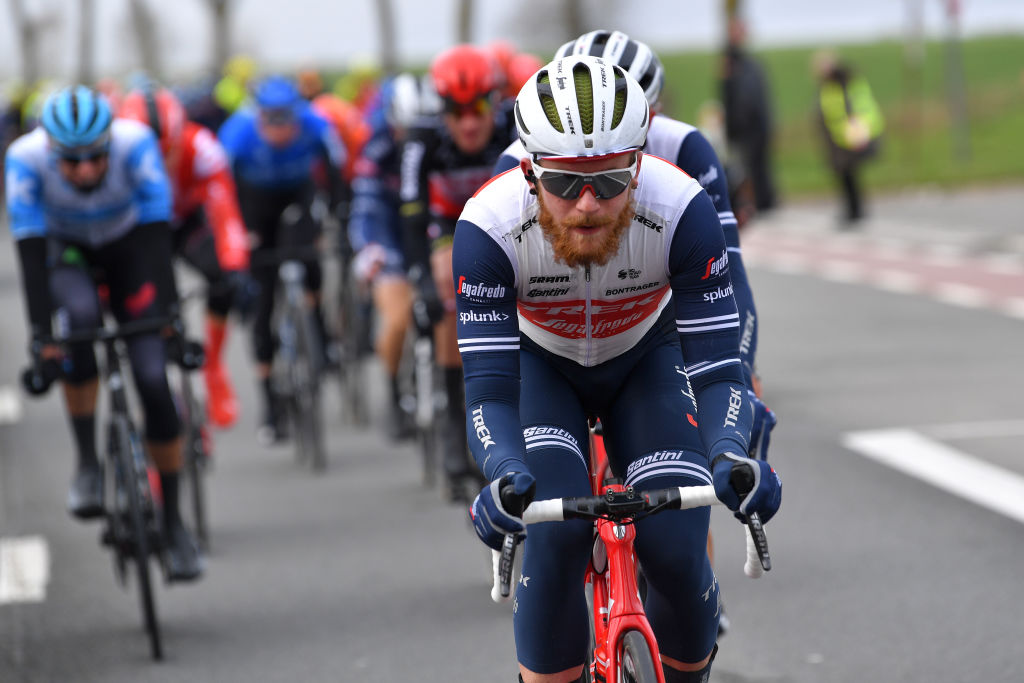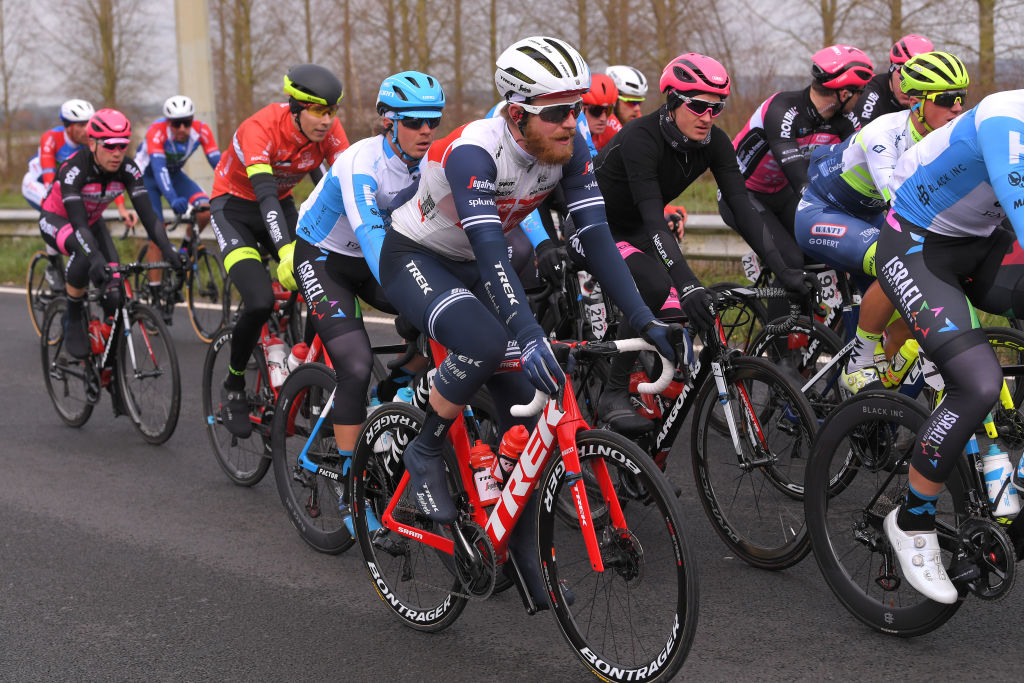Quinn Simmons: It'd be cool to have Fall Classics after losing the Spring Classics
18-year-old American talks about his debut with Trek-Segafredo and cycling life in lockdown in Durango

Quinn Simmons was quietly hoping to show off his precocious cobbled Classics talents at Paris-Roubaix this Sunday, but the COVID-19 pandemic has cancelled all the spring Classics and forced the junior road race world champion and Trek-Segafredo neo-pro to return to his home in Durango and reset his debut season.
Like all his fellow Classics riders, Simmons can only try to hold onto his base form in the hope that the Spring Classics become Autumn Classics.
“It's really weird for all of us, it's not something that a rider ever really thinks about. You perhaps factor in being injured or something but Paris-Roubaix not happening wasn't even a possibility in people's mind, yet here we are," Simmons tells Cyclingnews during a telephone interview.
“I'd have been the only 18-year-old ever to ride Paris-Roubaix, so it would have been cool. I just hope there will be more chances in the future but for other guys it won’t be easy because they were in the prime of their career. Jasper Stuyven was as having the best year of his career but now can’t show it and we don’t have many times like that. That's hard.
"Of course, we all know that there are bigger things in life, that are very important, especially everyone's health and the impact of the virus. But for us, as pro riders, it's our career, it's our livelihood, so it's been a blow. We're just on standby, waiting to know when we can all race again. Right now, it's about maintaining a base fitness for when we get that okay. We're all just waiting at this point."
Simmons had raced the Opening Weekend in Belgium, helping teammate Jasper Stuyven win Omloop Het Nieuwsblad. A few days later he completed a second recon ride of the Paris-Roubaix cobbled, then suddenly, with the Classics cancelling like dominoes, he jumped on plane with his young brother Colby, who was also in Europe to race with the Lux development team, and returned to the Simmons family home in Durango, Colorado.
"It was weird to go from one situation to another. One minute I was focused on the racing and training, the next I was at home and the spring was over," he says.
Get The Leadout Newsletter
The latest race content, interviews, features, reviews and expert buying guides, direct to your inbox!
Simmons enjoyed a few days off the bike, replacing training with some intense hiking and skiing. He has since rolled the clock back and begun his winter base training all over again. Unlike his teammates under strict lockdown in Italy, Spain and France, Simmons is able to train outdoors in the USA.
"I know I'm fortunate to still be able to ride," he says.
"Some people on social media have been grumpy about us riding in the US but we’re being careful and following the rules, just as I was when I went skiing. There's a slight risk but as long as we’re allowed to ride outdoors, I think it's okay. I've got a home trainer and I'm even leading some rides on Zwift but I hope we can keep riding outdoors."
Professional debut with Trek-Segafredo
Time at home in the USA has given Simmons time to look back at his short professional debut with Trek-Segafredo. His audacious solo attack at the World Championships in Yorkshire last
year confirmed the huge talent he had shown in the junior ranks and immediately elevated him among the next generation of riders emerging in the men's pro peloton, alongside Remco Evenepoel (Deceuninck-QuickStep), Pavel Sivakov and Egan Bernal (Team Ineos), Tadej Pogačar and Brandon McNulty (UAE Team Emirates). He is also part of a new generation of young Americans coming through after the black hole caused by Lance Armstrong's doping scandal.
Simmons symbolically wore his junior world champion's rainbow jersey ride during a winter training ride in Mallorca but quickly made the switch to being a young neo-pro who had to learn how to race all over again. Skipping the under-23 ranks has been done before but is risky,
with the demands of the WorldTour potentially often leading to burn-out, unfulfilled promise and short careers.
Simmons is fortunate to be mature beyond his years. He is talented and ambitious but also grounded about what he expects from his teenage years as a professional.
"I don’t think the physical difference between myself and some of the older pros is that different. Anyone who rides their bike a lot can ride their bike hard for six hours," he says.
"The big difference now is that I've got to relearn the tactics, learn how to position in the group and learn how to make the finale of the big race. It's a challenge but it's definitely worth it and should give me a head start. If I can start learning from everyone at Trek-Segafredo now and learning the secret of the races, then each year I'll make fewer and fewer mistakes. So by year three or four, I'll have all that experience that an under 23 rider who turns pro just won't have.
"I'm not too much into American sports but I suppose it's like going direct to the NBA without going to college. That's what people like Lebron James did and he seems pretty good now. Peter Sagan was winning stages at the Tour of California when he was real young too, so if
you're physically ready, and mentally you want to be there, it'd be crazy to wait."
Simmons showed his prodigious talents with two top ten results in two spring finishes at the Tour de La Provence in February. His debut season before the COVID-19 lockdown started at the Challenge Mallorca and ended with Le Samyn after the Opening Weekend in Belgium.
"My pro debut was real fun," he says.
"People saw the way the team started off successfully at the Tour Down Under, with Richie Porte winning overall. Then at the Challenge Mallorca, I made my debut and we won two days out of three with Matteo Moschetti. Then our run just continued up to Omloop and Jasper Stuyven won it well. I think that all showed how good of a Classics squad we had. We think that would have carried into the Monuments, so that's why it's such a bummer that we aren't getting a shot at that now."
Simmons didn’t finish Omloop Het Nieuwsblad, Kuurne-Bruxelles-Kuurne or Le Samyn. He did his job to help his team leaders, learnt what he could and then saved himself for the next race.
"Riding Omloop is super cool with the fans there and all but when you're racing and in the gutter, it's really just another Belgian bike race," he says.
"The level was more or less how I expected. For me it was about being able to help out the guys. I tried to stick to the plan because we knew that Jasper could win and to play a small role in that was great. My goal was to hold position near the front and do the turns when I needed to be there. Early on we had four guys in split, then we were organised and aggressive again. It was perhaps a different strategy from Trek-Segafredo than in the past but it seemed to work.
“I didn't try to finish or anything because I was told that when you do your job, you get out of there and think of the next race. But I was based in Ooudenaarde for two weeks and so got to train on the famous roads of the Classics even if it rained almost every day. It made everything so easy and was a good place to be. I can't wait to get back.”

The Classics in the Fall
Simmons is getting updates and support from his Trek-Segafredo coaches and staff. His chance to ride Paris-Roubaix has gone for the time being, but he is hoping to return to the cobbles of Flanders and northern France in the autumn.
"I think that'd be a good thing considering everything. Fans need their bike races and the racers and team need the races too, we kind of help and need each other. It'd be cool to have Fall Classics after losing the Spring Classics. Hopefully the Grand Tour guys can get their chances to race too," Simmons says with enthusiasm.
“Bike racing needs the Grand Tours and the Monument Classics, I don't think it can survive without them. A race like the Tour of Flanders or Paris-Roubaix mean so much to their countries in so many ways. It’s like being an American and not having the Superbowl, it just doesn’t seem right."
Simmons is trying to rebuild his calendar on new hopes and dreams. He had planned to ride the Dirty Kanza gravel race after some strong performances on the dirt in the past but with Dirty Kanza postponed to September 12, he will instead focus on the Autumn Classics and the World Championships.
"Hopefully we can have a shot at something in the Fall," he says. "It could be an interesting end of the year with Flanders, Roubaix and then perhaps Worlds; that would be cool. I think we'll race through November and so it'll be a long year.
"Everything will get a lot easier to understand and we'll all be a lot more motivated when we know when the races are back on, even if it's a fully-packed schedule. I think we'll all be happy to be back racing even if the preparation and training isn’t perfect. It's not just a performance question, we're also entertainers and so for the good of the sport, the sooner we can get back racing, the better for everyone."

Stephen is one of the most experienced member of the Cyclingnews team, having reported on professional cycling since 1994. He has been Head of News at Cyclingnews since 2022, before which he held the position of European editor since 2012 and previously worked for Reuters, Shift Active Media, and CyclingWeekly, among other publications.